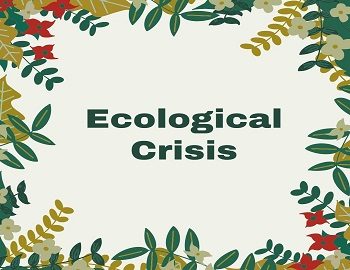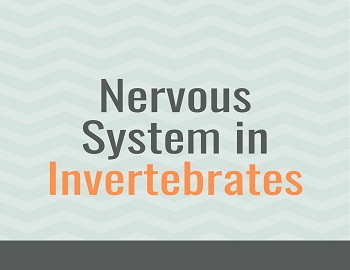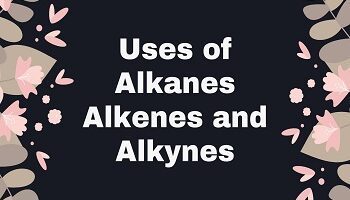Table of Contents
Ecological Crisis:
Ecological crisis is the severe ecological imbalance in nature.
Different forms of life (all plants, insects, birds, animals etc.) living in a particular area share a particular environment and depend on each other, directly or indirectly, for their survival. Such a type of association is said to form a system called biological community. A biological community survives only if it’s every species survives. This may be illustrated by means of the following examples-
- The secretary birds feed upon snakes. If they eat up all the snakes around then there would be no food left for them to feed upon and hence the secretary bird population will die out.
- The frogs eat insects which destroy the food crops and, thus, keep a check on their population. If the number of frogs is considerably reduced by killing them, the insect population will increase to the large extent giving harm to the human population which will starve.
- Carnivorous animals eat other animals. If they eat up all the animals around them, then their population will die out due to non-availability of food. The absence of herbivorous animals results in a tremendous growth of vegetation like grasses, creepers and bushes.
- Carnivorous animals feed upon herbivorous animals and thus, keep their number down. If the carnivorous animals are killed reducing their number to a large extent, the population of herbivorous animals will multiply considerably. Now the herbivorous animals will eat much more of vegetation and face food shortage.
Above examples indicate that living things depend on each other to survive and act as checks on each other and, thus, provide a complete balance in nature. This balance is referred to as ecological balance as ecology deals with the relationship of organisms with their living and non-living environments.
The survival of man depends upon different kinds of species and it is, therefore, for his benefit that a proper balance of living species is maintained in nature. But unfortunately, he has not responded well. Some examples of the irresponsible behaviour of man in this respect are given below-
- He has been using the substances for killing the harmful insects without taking care that these substances may not also be harmful to birds. Thus, many useful birds have been killed along with the harmful insects in different parts of the world.
- He has been cutting the trees for different purposes and, thus, destroying the forests. Removal of forests leads to variations in climate, brings heavy floods or causes droughts. In this way, he has given harm to different populations.
- He has been hunting and, thus, destroying the populations of different types of animals.
- He has been threatening the survival of other forms of life by the population explosion, i.e., by increasing the human population. The result of the irresponsible behaviour of man is a severe ecological imbalance which is known as the ecological crisis.
Let us now discuss the role of man in affecting biological community and the physical environment.
Crisis in the Biological Community:
Man is the only animal which can affect the biological community to the maximum extent because of his thinking power and the knowledge of science, technology and communication. He has affected the biological community in the following ways-
- Destruction of Forests: Man has been cutting down trees and, thus, destroying forests to clear forest areas for industries, cities, dams, hydroelectric projects etc. When trees are cut, the populations of many plants and animals disappear. This also results in several problems like floods, soil erosion, drought and famines.
- Destruction of Wild Life: Man has destroyed many animals and birds by hunting for mere sport or out of material greed. Due to excessive hunting of some species of animals and birds, they are facing extinction. Some animals and birds facing extinction are the lion, the Kashmir stag, the musk deer (animals), the Great Indian Bustard, and the white-winged wood duck (birds). Excessive hunting of carnivorous animals leads to an increase in the number of herbivorous animals which then damage the topsoil and cause soil erosion by grazing excessively. Due to this, herbivorous animals face food shortage.
- Technological advancement: The advancement in technology (increase in industries, factories, power plants etc.) is producing various side effects by polluting air, water and land. Example- Industrial wastes pollute the sea and river waters and affect the population of many aquatic plants and animals.
- Over-population: Man has not taken proper care to check the population of his own species. To meet the increasing demands of the rising human-population, man has encroached upon the forests and the mountains for food and space. This has produced climatic changes and caused disturbances in natural food chains and food webs. Over-population affects the progress of the country very badly.
Crisis in the Physical Environment (Land, Water, Air and Noise Pollution):
Biological community and the physical environment are inter-related and as such any change in the biological community, brought about by a man, affects the physical environment. How man has affected the physical environment is described below-
Land:
Man destroys forests by cutting the trees. Destruction of forests by man leads to loss of fertility in a land which then becomes barren, i.e., unproductive. This is because the fertile land is covered with or surrounded by trees which protect the land in the following ways-
- Trees lessen the force and speed of a strong wind and, therefore, act as wind breakers. By behaving in this way, the trees do not allow the wind to carry away the fertile top soil and, thus, prevent it to cause any soil erosion.
- Trees hold the soil firmly together by means of their roots and, thus, save the fertile soil from being washed away by the rain or floods.
- When trees die, they are decomposed into the material humus, which mixes with the top soil and increases its fertility by making it rich in nutrients.
By destroying many forests, man has converted many areas of fertile land into barren areas and finally into deserts. One such example is the Thar desert which was, at one time, a thick forest.
Water:
Water is an essential part of all living organisms and it helps in almost all the metabolic processes. It is used for drinking, cooking, irrigation, washing, cleaning and generating energy. In spite of all this, man has not treated water with the utmost care and consequently he is facing water shortage or crisis in water. A water crisis is the result of the crisis in forests and the pollution of water.
Crisis in forests, brought about by man by cutting trees, has led to a crisis in water. In a normal and healthy environment, the land has many trees which hold its soil firmly together by means of their roots. When the rain waterfalls, the water falling on the ground flows along the slopes and fill up pools, rivers and ponds. A part of the rainwater seeps gently underground. The underground water then, under suitable conditions, makes its reappearance on the surface of the land in the form of springs, lakes etc. Thus a steady supply of water is maintained throughout the year. If there are no trees, then the rainwater does not percolate through the soil but remains on the surface of the land and thus causes floods. In this way, the waters well as the topsoil are carried away. In the absence of underground water, we face water shortage during the dry season. It is due to the removal of forests that some areas in India face floods at one time and drought at another.
Pollution also brings about water-shortage. There are three types of water pollution for which man is responsible. These are-
- Contamination from Industrial Wastes- This is the most dangerous water pollution. Industries discharge their harmful waste materials into the rivers, lakes and ponds, and, therefore, pollute the water. Dumping of oil and radioactive waste in the ocean are other contaminants which pollute water and make it harmful for aquatic plants and animals.
- Contamination from Sewage- Sewage of big cities is usually drained into rivers. This has promoted the growth of phytoplankton. The excessive growth of phytoplanktons reduces the oxygen content of water and thus produces the poisonous effect on the fish population, which is one of our major sources of food.
- Contamination from bathing and washing- Rivers, lakes and ponds are, directly, used by people for taking bath and washing dirty clothes etc. This pollutes the water which then becomes the source of germs of various diseases, typhoid, cholera, dysentery etc.
Air:
All living organisms require air. It flows unrestricted from one place to another and has, therefore, no boundary wall. It is, thus, common to all plants and animals including human beings. We require trees for fresh air. All animals use oxygen of the air and give out carbon dioxide in exchange when they breathe. The green plants, while synthesizing food, take in carbon dioxide and give out fresh oxygen. They, thus, purify the air for animals including human beings. Air becomes polluted when some harmful substances are added to it. For example- smoke which carries carbon particles, carbon dioxide and carbon monoxide. Smoke gets into the air from different sources (such as kitchens, factories, automobiles, trains and aeroplanes). Tests of nuclear weapons add radioactive dust to the air and make it very harmful to human health. By cutting trees, which purify the air, man is increasing the chances of more and more air pollution.
Air pollution is a serious problem in big cities. In big cities, air gets polluted because of various reasons such as the presence of industries and automobiles, over-crowded areas and lack of vegetation.
Noise Pollution:
Noise pollution is caused by different types of sounds produced by human beings, automobiles, radio, railway engines, aeroplanes etc. Constant exposure to noise results in deafness and increase blood pressure, nervous tension and heart trouble. Noise also causes vibrations in the buildings and disturbances to the students in their studies.
- Cloud Formation And Types of Clouds
- Ecosystem
- Ecological Pyramids and its Types
- Ecological Succession or Biotic Succession
- Important Biogeochemical Cycles
- Global Warming: Effects and Control Measures
- Disaster Management
- Physiography Of India
- Rivers of India
- Seasonal Rhythm Of Indian Monsoon
- Forest and Wildlife Resources
- Geography Of India By Nitin Sangwan









Comments (No)